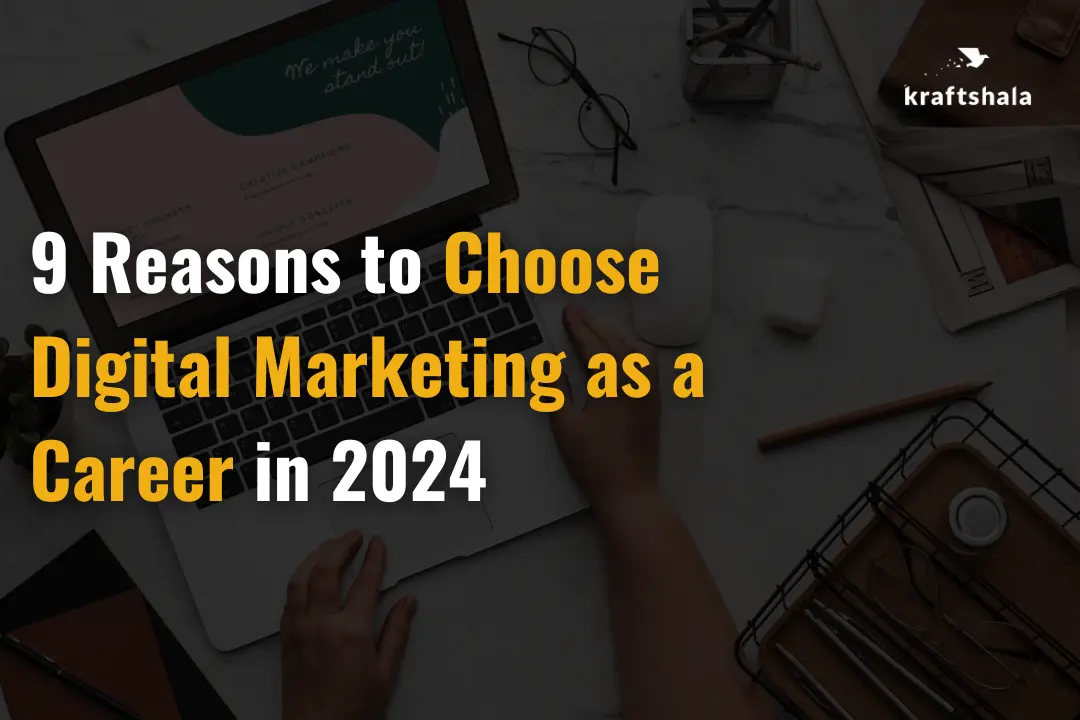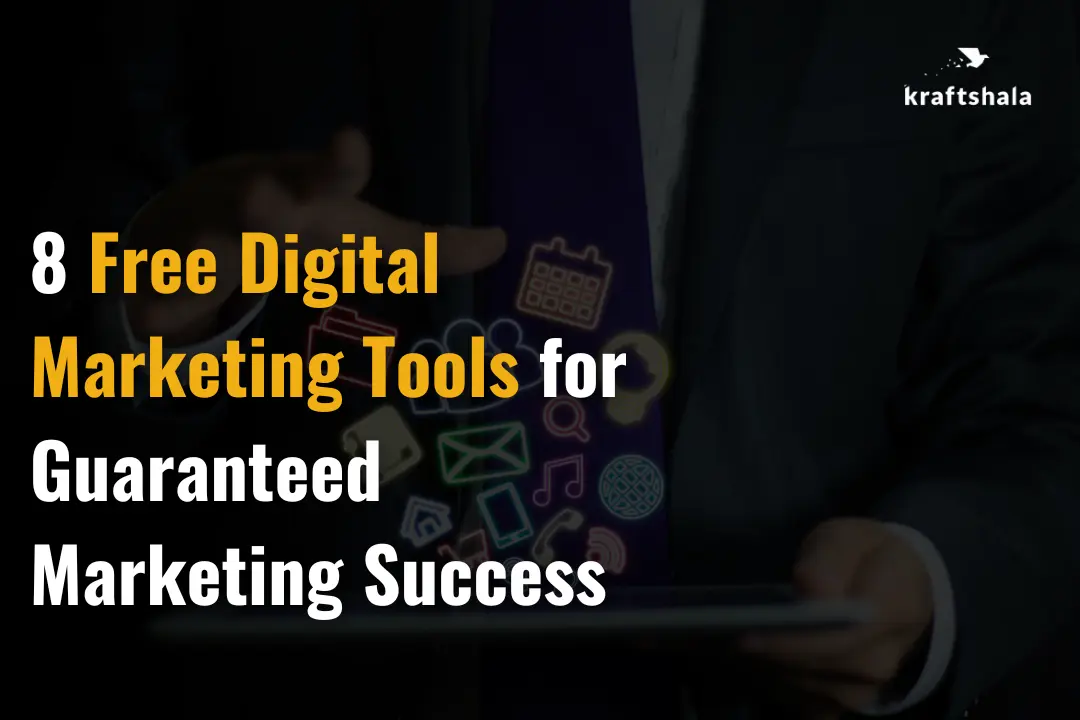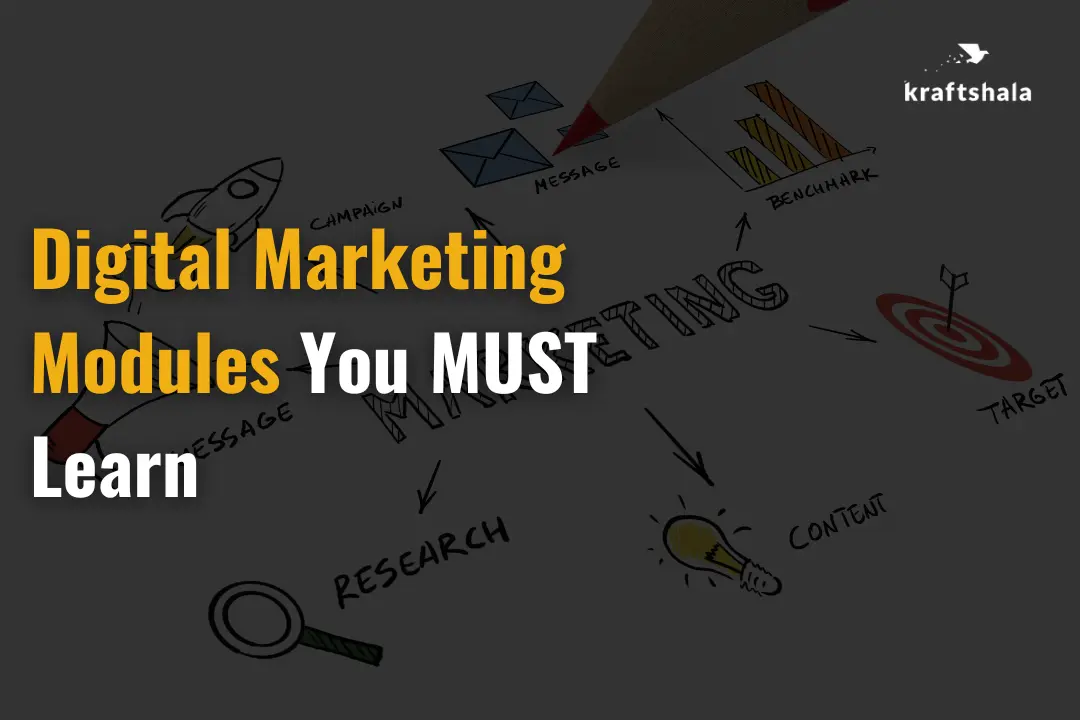SEO vs SEM: What’s the Difference and Which is Better for Your Career?
Table of contents
- What is Search Engine Optimization (SEO)?
- What is Search Engine Marketing (SEM)?
- SEO vs SEM: Which is Better?
- Career in SEM: What is It Like to Be an SEM Specialist?
- Career in SEM: What is It Like to Be an SEM Specialist?

“If your business is not on the internet, then your business will be out of business.”
– Bill Gates, Co-Founder, Microsoft
Bill Gates’s statement made in the mid-1990s still holds true to this date. It was at the time when the Internet was still in its nascent stages and businesses were hesitant to establish their online presence.
Since then, Google, among other search engines has become the go-to place for marketers to build a website, showcase their products and get users. In fact, according to sources , Google approximately processes 8.6 Billion searches per day.
According to Statista , as of January 2023, Google has a global market share of 84.69% and establishes itself as the market leader. So much so, that marketing in search engines is synonymous with marketing on Google.
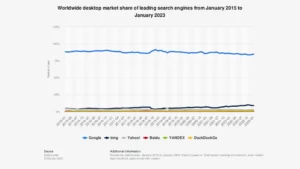
Source: Statista
Now, this comprises two things: SEO and SEM. Though they seem similar terms, they vary. To understand the difference between SEO and SEM, and understand the whole of search and how you could become a marketer of it, dig right into this blog.
What is Search Engine Optimization (SEO)?
Search Engine Optimization (SEO) is the process of optimizing a website and its content (all the many pages a website has) to rank higher in search engine results pages (SERPs). The process ensures that your website appears as high as possible in search results when people search for specific keywords or phrases related to your business or industry.
Simply put, search engine optimization is the process of ranking your website #1 on search results.
Like, when you search for something on a search engine, you’re presented with a list of websites in search results. Now, if you have a website, you would want the maximum number of people to reach your website, and check out what you’ve got.
Here comes SEO. It aims to improve your website’s ranking in those search results and get your website to appear on the first page of search results and rank as high as possible.
For example, let’s search “digital marketing course with placement” on Google.
As you hit enter, the search results appear to be:
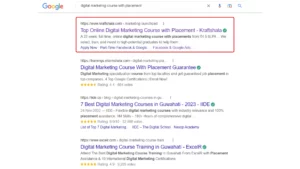
With the help of SEO, Kraftshala’s digital marketing course with placement now ranks #1. But, how does this happen?
The Components of SEO:
Now consider the same example – Kraftshala’s digital marketing course with placement page that’s ranking #1. To make this page rank involved quite a few techniques. These techniques are actually parts of SEO that make it whole.
Consider a car. What makes the car run is its components like the engine, fuel, wheels, and even the one who drives the car – the driver. Now, you miss one component and the car stops working. Now, let’s compare these components of a car to the components of SEO.
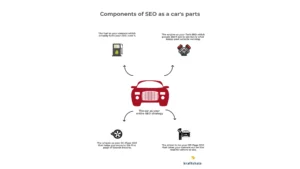
These are:
Content:
This is the fuel of your search engine optimization. Content is what fuels your SEO, runs it, and acts like a product that appears on the search results repository when one searches for a relevant search query related to your content.
Content is a crucial factor in SEO because search engines depend on it to provide relevant and high-quality results to their users. When people search for specific keywords or phrases on search engines, the search engine algorithms analyze the content of various web pages to determine which pages are the most relevant and useful to the user’s search query.
Websites with high-quality, informative, and relevant content then rank higher in search results to keep the users interested and give them information.
How Content Works: Content that is of high quality and is well-optimized for search engines helps pages rank higher in search results for relevant keywords (On-Page SEO), keeps users on a website for longer, and attracts links from other websites (Off-Page SEO), which is one of the most important ranking factors in SEO.
And eventually, content then helps in attracting more traffic from search engines and in conversion.
On-Page SEO:
On-Page SEO is the wheels of an SEO strategy. The way a car’s wheels help the car move, On-Page SEO helps pages move higher on the search results. This increases their visibility by understanding their topic relevance, making it easier to match it with relevant search queries.
On-page SEO (Search Engine Optimization) is the practice of optimizing the content and HTML source code (the underlying code used to create and structure the content) of a webpage to make it more search engine friendly. This helps search engines understand the relevance and topic of a webpage, making it easier to match it with relevant search queries.
Like, how Kraftshala’s course comes up at #1 for the query – “digital marketing course with placement ”.
We do this by optimizing meta tags, headers, and content with keywords like “digital marketing course with placements” and other relevant keywords that can help search engines understand the topic of a webpage and make it easier to include in search results.
This ensures that search engines can easily crawl and index the webpage, improving its visibility show up in relevant search results.
Off-Page SEO:
Off-Page SEO is the driver of your SEO that takes the car out on the road, much like it takes a website’s content out in the world to show it to good websites.
Off-page SEO (Search Engine Optimization) is actions that are taken outside of a website to improve its visibility and ranking in search engine results pages (SERPs). Think of how good people know other good people, it’s a website’s way of networking with other credible websites.
Off-page SEO involves improving the website’s authority, relevance, and trustworthiness by earning backlinks from other high-quality websites. Backlinks are one of the most important ranking factors in search engine algorithms. By building a high-quality backlink profile, a website can demonstrate its authority and relevance to search engines, leading to higher rankings in search results.
Off-page SEO can also involve social media marketing, influencer outreach, and other strategies to promote a website and its content on other online platforms.
Technical SEO:
This is the engine of your SEO. Think of a car’s engine. See how it is the core component that powers and drives the vehicle, like every minor detail matters and helps optimize the overall car health, technical SEO is the foundational component that powers and drives a website’s health, its search engine visibility, and user experience.
Technical SEO is the process of optimizing a website’s technical infrastructure to improve its visibility and ranking in search engine results pages (SERPs). It involves optimizing elements such as website speed, mobile-friendliness, crawlability, and security to ensure that search engines can easily crawl and index a website.
A technically sound website can help search engines understand the content and relevance of a website, leading to higher rankings in search results.
Technical SEO also involves optimizing the website’s structure and HTML source code, ensuring that it is easy for search engines to read and understand. It is also a core component that improves the website’s user experience, ensuring that visitors can navigate the site easily and find the content they are looking for.
And together, these components make a website win in the search engines.
What is Search Engine Marketing (SEM)?
Search engine marketing (SEM) is a digital marketing strategy that involves marketing on search engine result pages (SERPs), just like its name suggests. It does so by using both paid search advertising (PPC) and search engine optimization (SEO) to promote a website or business in search results.
Like, when we search “digital marketing course with placement” on Google, we’ll first come across ads like this:
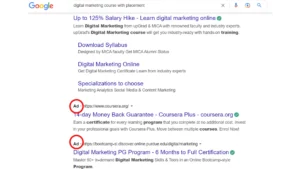
That is a result of PPC advertising. And as you scroll further down, you’ll finally come across the organic websites that are ranking…
Together, paid and organic form the basis of search engine marketing.
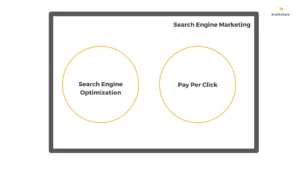
One thing for you to note: While SEM involves both SEO and PPC, over time, SEM is often used to specifically refer to the paid search advertising component of search marketing. It primarily focuses on using paid advertising to promote a website or business in search engine results pages (SERPs).
So, a revised definition of SEM would be: “the process of getting maximum traffic to your website by purchasing ads on search engines.”
But, not to forget the original meaning of it.
So, Then What Are the Components of SEM?
SEM or Search Engine Marketing involves various components that work together to improve a website’s visibility on search engines and drive traffic. The main components of SEM are:
SEO (Search Engine Optimization):
This involves optimizing a website’s content and structure to rank higher on search engine results pages (SERPs) for specific keywords. SEO is an important component of SEM, as it helps improve organic traffic and visibility.
PPC (Pay-Per-Click Advertising):
This involves running ads on search engines like Google, where advertisers pay a fee each time their ad is clicked. PPC can be used to drive targeted traffic to a website and generate leads or sales quickly.
Ad Copies:
Ad copies are the text or media used in PPC ads, which are designed to attract clicks from search engine users. Ad copies should be relevant, persuasive, and engaging to attract clicks and improve the ad’s click-through rate (CTR).
Local Search:
This involves optimizing a website for local search queries and appearing in Google’s local pack or map pack. Local search can be used by businesses that have a physical presence in a particular area to attract local customers.
Web Analytics:
This involves analyzing website data to measure the success of SEM campaigns and make data-driven decisions. Web analytics can help track key metrics like traffic, conversions, and revenue, and identify areas for improvement.
To sum all these components up:
Let’s consider Kraftshala, a brand that sells digital marketing courses. Kraftshala could use SEO to optimize their website content and structure to rank higher on search engines for keywords like “digital marketing courses” or “online marketing courses.”
They could also use PPC advertising to run ads on search engines and social media platforms to attract targeted traffic and generate leads or sales.
Kraftshala could also use local search optimization to appear in Google’s local pack for searches like “digital marketing courses near me.”
Ad copies would be used to create compelling and relevant PPC ads that attract clicks and generate conversions. Finally, web analytics would be used to track key metrics like traffic and conversions, and make data-driven decisions to improve SEM campaigns.
As for when to use what, it depends on the brand’s goals, budget, and target audience. SEO is a long-term strategy that requires patience and consistency, while PPC can generate quick results but requires a budget.
SEO vs SEM: Which is Better?
There are a few factors to consider to compare the two strategies.
SEM is like an entire box of chocolate bars. The box contains chocolate bars named PPC and SEO which are two different strategies for marketing in search engines.
So, deciding between SEO and SEM (synonymous with PPC) depends on your specific business goals and resources. Both SEO and SEM have their own advantages and disadvantages. Following are some of them.
SEO vs SEM: How Long Does it Take to See Results?
With Pay-Per-Click Advertising:
PPC or pay-per-click advertising can start delivering results as soon as your ad campaign is live. However, the time it takes to see meaningful results can vary depending on several factors, such as your budget, competition, and the quality of your ad campaign.
For example, let’s say you run a small business selling handmade jewelry, and you want to drive more traffic to your website through PPC advertising. You set up an ad campaign on Google Ads, targeting keywords related to “handmade jewelry,” and you allocate a budget of $500 per month. Your ads start running immediately, and within a few days, you begin to see clicks and visits to your website.
However, to see significant results, it may take several weeks or even months of ongoing optimization and testing to improve the performance of your ads, increase click-through rates, and lower your cost-per-click. With ongoing attention and optimization, you can continue to refine your campaign, improve your ad targeting, and drive more traffic and sales over time.
One disadvantage of using PPC is that it can be expensive, especially if you’re in a highly competitive market. Costs per click can quickly add up, and if your budget is too small, your ads may not generate enough clicks or visits to make a significant impact on your business. Additionally, if your ad campaign is not properly optimized or targeted, you may end up wasting money on clicks that don’t convert into sales or leads.
With Search Engine Optimization:
The time it takes to see results from SEO can vary depending on several factors, such as the competitiveness of your industry, the quality of your website, and the amount of effort you put into optimizing your website for search engines. It can take several weeks or even months to see meaningful results.
For example, let’s say you run a small business selling handmade soaps, and you want to improve your website’s visibility in search results. You invest time and resources into optimizing your website for relevant keywords, improving your website’s user experience, and building high-quality backlinks to your site.
Over the next few weeks and months, you may begin to see your website’s rankings improve for targeted keywords, leading to an increase in organic traffic and ultimately, more sales for your business. However, it’s important to note that SEO is an ongoing process that requires consistent effort and attention. To see continued results, you must continue optimizing your website and creating high-quality content.
One disadvantage of SEO is that it can be a slow process. It can take several months to see significant improvements in your website’s rankings and traffic, especially if you’re in a highly competitive industry. Additionally, the algorithms used by search engines like Google are constantly changing, which means that your SEO strategy may need to evolve over time to stay effective.
SEO vs SEM: How Much Do They Cost?
The cost of SEO and SEM can vary widely depending on several factors, such as the competitiveness of your industry, the size of your business, and the specific strategies and tactics you use.
SEO is generally considered to be a more long-term investment, as it focuses on improving your website’s organic search visibility over time. The cost of SEO can range from a few hundred to several thousand dollars per month, depending on the size of your website and the scope of your optimization efforts.
For example, if you run a small business selling pet supplies online, you might work with an SEO agency to improve your website’s rankings for keywords like “dog food,” “cat toys,” and “pet grooming supplies.” The agency might charge you a monthly fee of $500-$2,000 to conduct keyword research, optimize your website’s content, and build high-quality backlinks to your site.
In contrast, SEM typically involves more immediate, short-term results, as it involves paying for advertising space on search engine results pages (SERPs). The cost of SEM can vary widely depending on the competition for your chosen keywords and the size of your target audience.
For example, if you run a local dental practice, you might use SEM to target people searching for “teeth cleaning” or “dental implants” in your area. You might set a daily budget of $50-$200 to place ads on search engine results pages for those keywords.
It’s worth noting that while SEM can provide more immediate results, it can also be more expensive in the long run. As soon as you stop paying for ads, your visibility in search results will decrease. Additionally, the cost per click for popular keywords can be quite high, meaning that you may need to spend a significant amount of money to see meaningful results.
SEO vs SEM: When to Use What?
When deciding between SEO and SEM, it’s important to consider your business goals and budget. SEO is a long-term strategy that can take time to see results, but it can also be more cost-effective in the long run. On the other hand, SEM can offer more immediate results but can be more costly.
For example, let’s consider Kraftshala, a brand that sells digital marketing courses. If Kraftshala wants to improve its visibility in search engines and drive organic traffic to its website, it could invest in SEO tactics such as optimizing its website content, building backlinks, and improving its website’s technical structure. This strategy can take time to see results, but it can also be cost-effective in the long run as the traffic generated from organic search is free.
Alternatively, if Kraftshala wants to quickly increase its website traffic and generate leads, it could invest in SEM tactics such as Google Ads. By bidding on relevant keywords and creating targeted ads, Kraftshala can quickly drive traffic to its website and potentially generate more leads. However, this approach can be more expensive in the short term as each click on the ad incurs a cost.
Ultimately, the decision to use SEO, SEM or a combination of both depends on the brand’s specific goals, budget, and timeline.
Career in SEM: What is It Like to Be an SEM Specialist?
As an SEM specialist, you would be responsible for implementing strategies to drive traffic and improve the visibility of a website in search engine results pages (SERPs). This involves a combination of both SEO and PPC tactics.
- For SEO, you would need to conduct extensive keyword research, optimize website content, build quality backlinks, and monitor website performance using web analytics tools. This would require a strong understanding of technical SEO, on-page optimization, off-page optimization, and content creation.
- For PPC, you would be responsible for creating and managing paid advertising campaigns using platforms such as Google Ads and Bing Ads. This involves setting up ad campaigns, selecting keywords and ad targeting options, writing compelling ad copies, and analyzing campaign performance using web analytics tools.
Being an SEM specialist requires a blend of technical, analytical, and creative skills. You need to be able to analyze data, identify trends, and develop effective strategies to improve website traffic and conversions. It can be a dynamic and fast-paced career that offers opportunities for growth and learning.
Career in SEM: What is It Like to Be an SEM Specialist?
As an SEO specialist, you would be responsible for optimizing websites to improve their search engine rankings and drive organic traffic. This involves conducting keyword research, optimizing website content and structure, building backlinks, and analyzing website data to make informed decisions.
You would also need to stay up-to-date with the latest industry trends and search engine algorithms to ensure your optimization strategies are effective.
With that said, the career trajectory in both SEO and SEM may look somewhat like this:
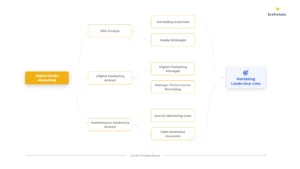
And while you might be wondering about salary, with Kraftshala’s Facebook and Google Ads Course and Search Engine Optimization Course , the salary compensation will look like:
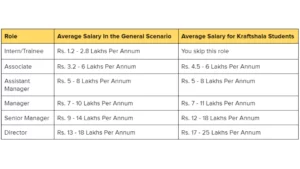
If you’re interested in knowing more about these specializations, check out Kraftshala’s blog on digital marketing specialization .

